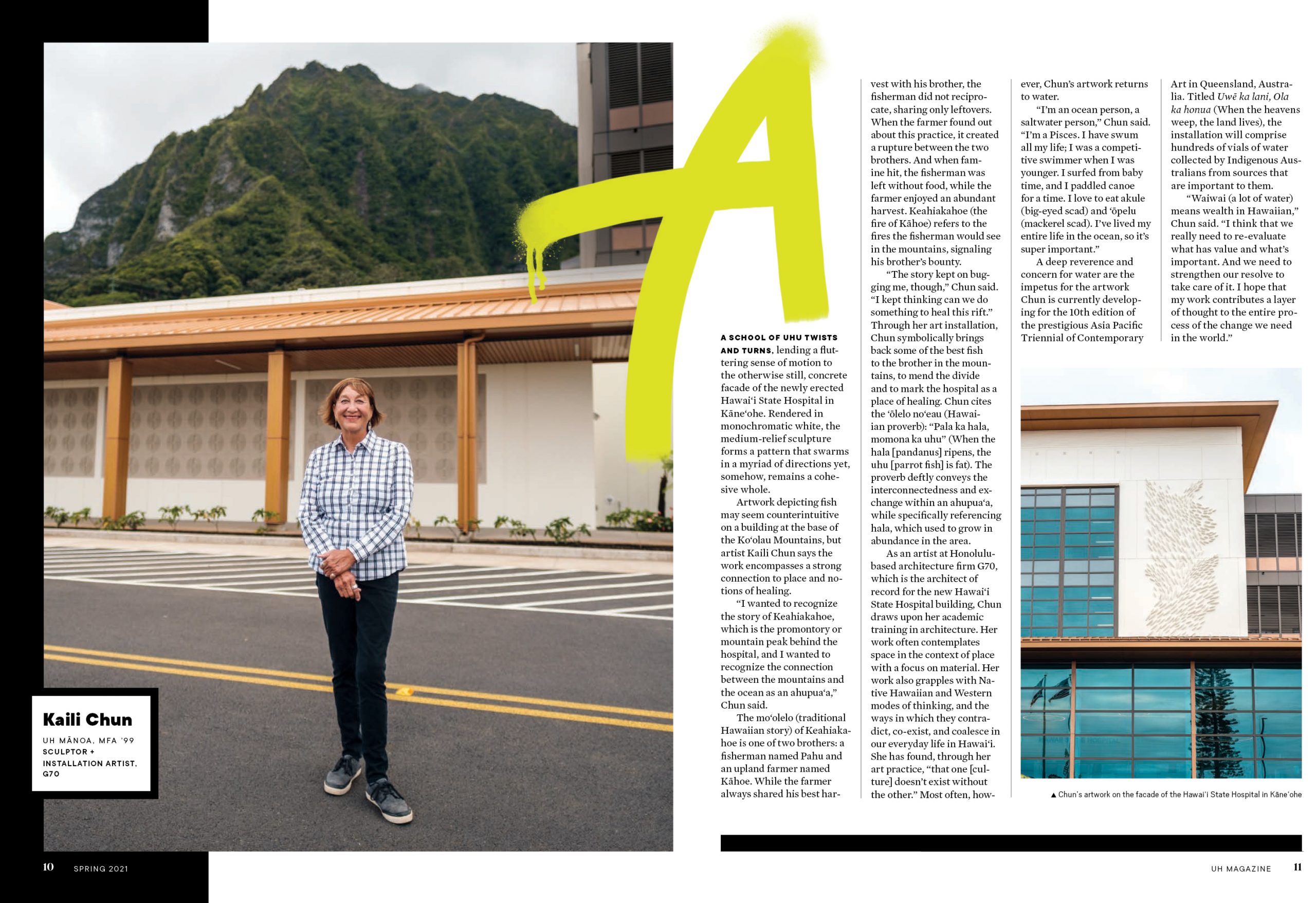A SCHOOL OF UHU TWISTS AND TURNS, lending a fluttering sense of motion to the otherwise still, concrete façade of the newly erected Hawai‘i State Hospital in Kāne‘ohe. Rendered in monochromatic white, the medium-relief sculpture forms a pattern that swarms in a myriad of directions yet, somehow, remains a cohesive whole.
Artwork depicting fish may seem counterintuitive on a building at the base of the Ko‘olau Mountains, but artist Kaili Chun says the work encompasses a strong connection to place and notions of healing.
“I wanted to recognize the story of Keahiakahoe, which is the promontory or mountain peak behind the hospital, and I wanted to recognize the connection between the mountains and the ocean as an ahupua‘a,” Chun said.
The mo‘olelo (traditional Hawaiian story) of Keahiakahoe is one of two brothers: a fisherman named Pahu and an upland farmer named Kāhoe. While the farmer always shared his best harvest with his brother, the fisherman did not reciprocate, sharing only leftovers. When the farmer found out about this practice, it created a rupture between the two brothers. And when famine hit, the fisherman was left without food, while the farmer enjoyed an abundant harvest. Keahiakahoe (the fire of Kāhoe) refers to the fires the fisherman would see in the mountains, signaling his brother’s bounty.
“The story kept on bugging me, though,” Chun said. “I kept thinking can we do something to heal this rift.” Through her art installation, Chun symbolically brings back some of the best fish to the brother in the mountains, to mend the divide and to mark the hospital as a place of healing. Chun cites the ‘ōlelo no‘eau (Hawaiian proverb): “Pala ka hala, momona ka uhu” (When the hala [pandanus] ripens, the uhu [parrot fish] is fat). The proverb deftly conveys the interconnectedness and exchange within an ahupua‘a, while specifically referencing hala, which used to grow in abundance in the area.
As an artist at Honolulu-based architecture firm G70, which is the architect of record for the new Hawai‘i State Hospital building, Chun draws upon her academic training in architecture. Her work often contemplates space in the context of place with a focus on material. Her work also grapples with Native Hawaiian and Western modes of thinking, and the ways in which they contradict, co-exist, and coalesce in our everyday life in Hawai‘i. She has found, through her art practice, “that one [culture] doesn’t exist without the other.” Most often, however, Chun’s artwork returns to water.
“I’m an ocean person, a saltwater person,” Chun said. “I’m a Pisces. I have swum all my life; I was a competitive swimmer when I was younger. I surfed from baby time, and I paddled canoe for a time. I love to eat akule (big-eyed scad) and ‘ōpelu (mackerel scad). I’ve lived my entire life in the ocean, so it’s super important.”
A deep reverence and concern for water are the impetus for the artwork Chun is currently developing for the 10th edition of the prestigious Asia Pacific Triennial of Contemporary Art in Queensland, Australia. Titled Uwē ka lani, Ola ka honua (When the heavens weep, the land lives), the installation will comprise hundreds of vials of water collected by Indigenous Australians from sources that are important to them.
“Waiwai (a lot of water) means wealth in Hawaiian,” Chun said. “I think that we really need to re-evaluate what has value and what’s important. And we need to strengthen our resolve to take care of it. I hope that my work contributes a layer of thought to the entire process of the change we need in the world.”
